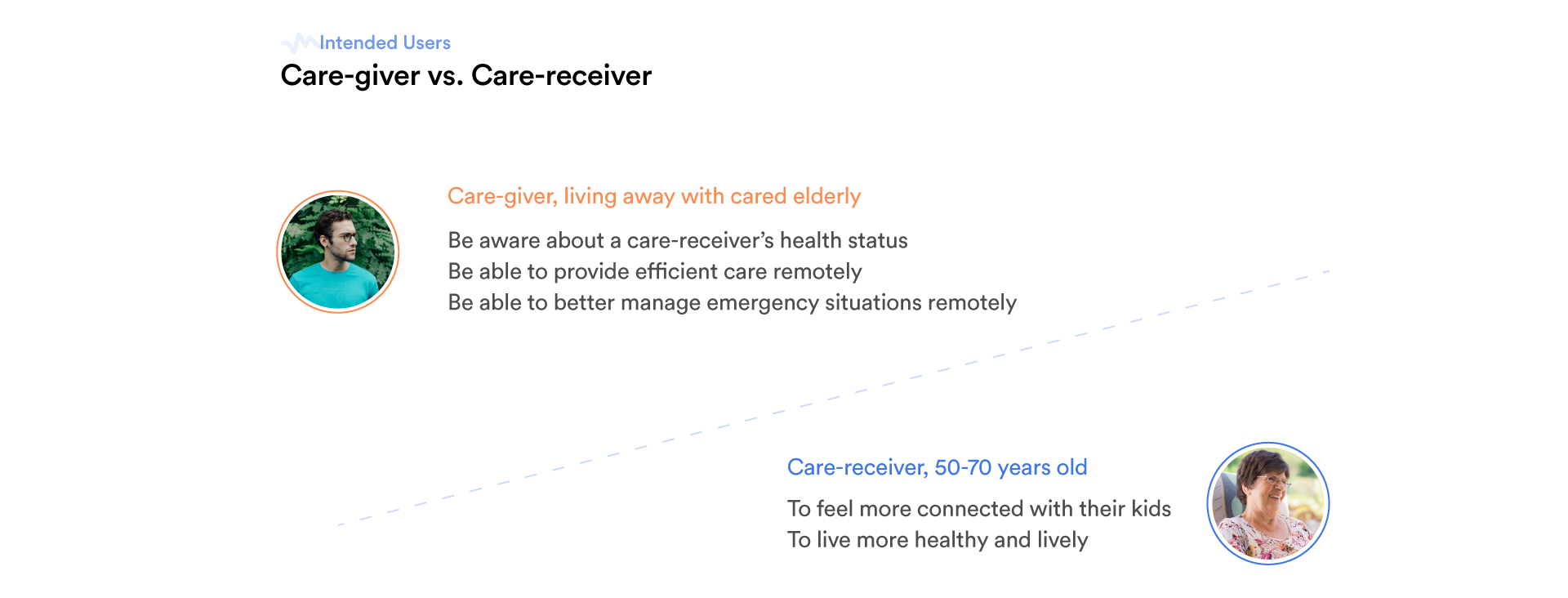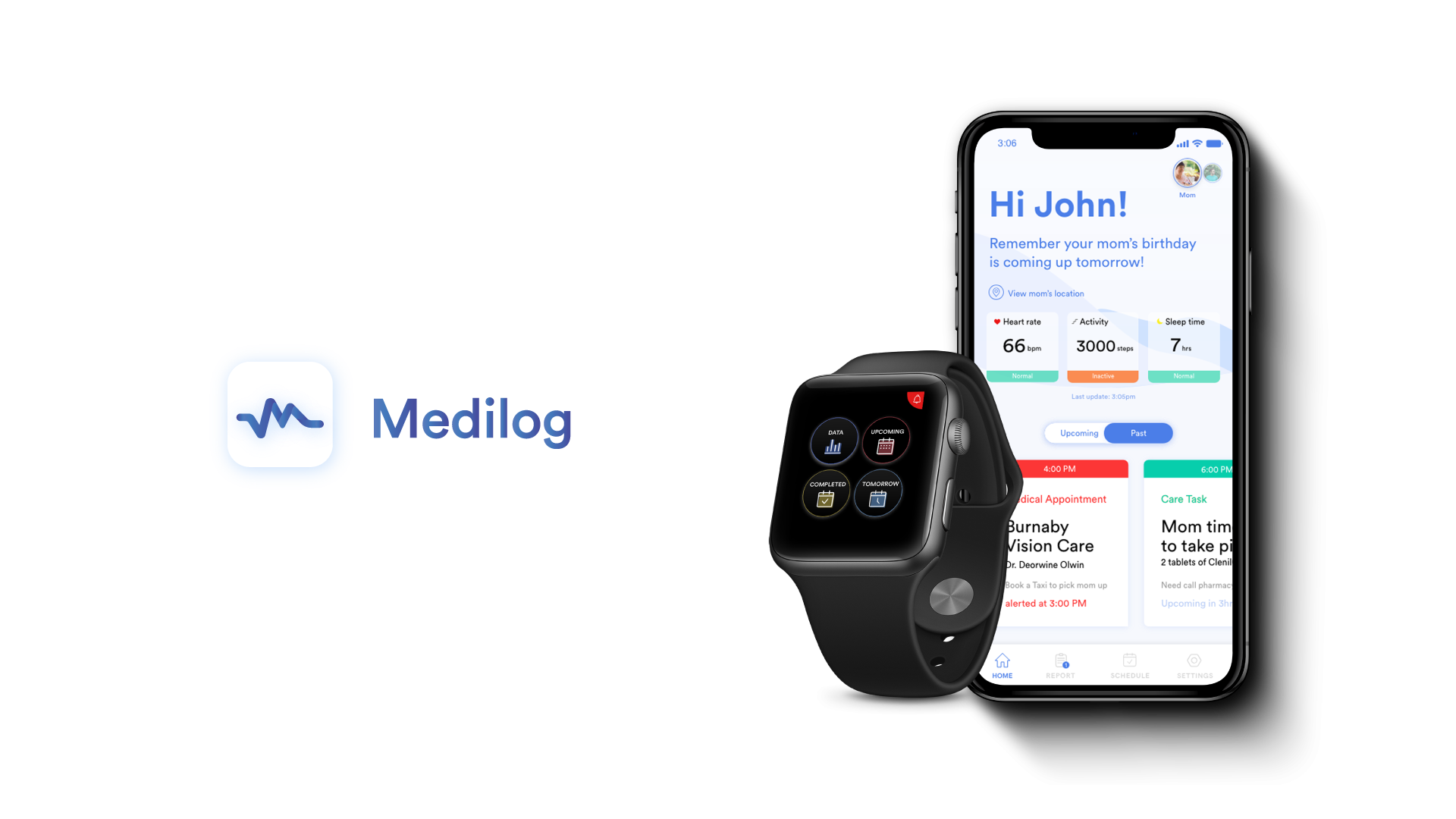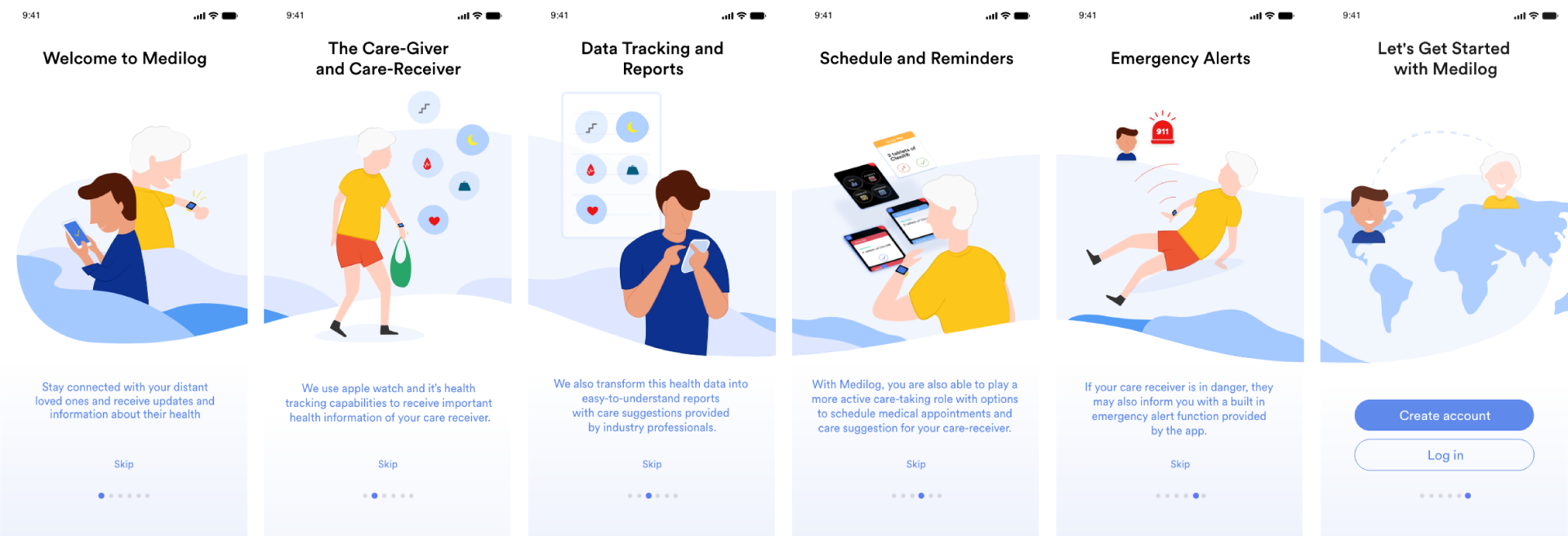Medilog is a health-supporting app that updates family members with the elderly's health status through wearable technology.
Medilog is a health-supporting app that updates family members with the elderly's health status through wearable technology.
Nowadays many young adults are moving from city to city and living away from their aging family members. Seniors who live alone and without the support of their younger guardians are facing many difficulties in maintaining a healthy lifestyle due to deteriorating chronic diseases and retention. At the same time, the distant young guardians also have a hard time keeping updated on the elderly’s health status and providing care remotely.
In 2010, nearly one third of older adults living outside of nursing homes or hospitals lived alone.
65% of older adults with long-term care relies on family and friends to provide assistance.
Estela, one of our teammates, has been worrying about her grandmother’s health conditions when she is living away from other family members. Estela’s grandmother is 78 years old and her partner has passed away. She usually lives with her daughter’s family in Toronto, but also spends a couple of months in China living by herself once in a while. She has high blood pressure and some other chronic diseases caused by aging, which requires her to take pills daily and keep on a light diet. Estela’s family is always concerned about whether she can maintain a healthy lifestyle when she is living alone and worries that no one would be around to help her in case of an emergency.
Based on the problem found and real-life scenario, we framed two questions to guide our further research:
How might we build connections between the elderly and their distant families through a simple app?
How might we provide efficient and effective health care through remote devices?
We looked into wearable technology because it allows the elderly to measure their health status effortlessly. We identified four opportunities from connecting the elderly with their distant caregivers with wearable devices:
Distant senior care has been a social issue as the result of civilization, while the younger generations are moving away from their hometowns. Trying to solve this problem, our ideas were more ambitious at the brainstorming stage, such as linking the app with the hospital system and giving specific medical analysis. After interviewing some medical professionals, I acknowledged some critical challenges that we could be facing if we defined the app in the medical category. The challenges are ranging from different perspectives:
For the sake of the accuracy of medical diagnosis, I suggested to focus the intended audience on the distant elderly and their young caregivers instead of medical professionals. One significant decision we have made is to keep the app family-friendly with general lifestyle suggestions rather than specific medical treatments.

Based on the personas on both caregiver and care-receiver, I found that there are distinctive needs and concerns on both sides. When designing the app, I kept in mind that considering both perspectives is critical to ensure satisficing experience from both audiences. Our team identified the following key goals for the caregivers and the care-receivers.

Estela and Nussy took the role of developing three user journey maps to understand both caregivers and care-receivers for their experience of setting up profiles and using the app in the daily routine.
We found the touch points are around the process of profile setup, collecting data, and receiving care reminder. The user journey gave us a few insights on designing the app.
Medilog is a health-supporting app that updates family members with the elderly's health status through wearable technology. The caregiver can track real-time health data of the care-receiver, getting monthly reports, collaborate with care-receiver on the schedule, and receiving emergency alerts. The app functions based on the connection between an Apple Watch and any mobile phone using the application.

The onboarding uses a cartoonish and narrative illustration to highlight key information about the application, including how to setup and get started, and its main features.
I created this onboarding illustration with an inspiration from Maria Soloveva’s illustration for Simuka.

Azure as a theme colour provides a hygienic touch for Medilog but might cause a clinic-look if overused. Therefore, I brightened up the theme with a few warm and vibrant colours as the secondary colours in order to create a cosy and welcoming impression. Arbitrary curves are also widely used in this 2D illustration to mimic a lavish hand-drawing style.
One feedback that we gained from the primary user testing was the complexity of the app functions, including how to pair up devices and data collecting methods. To help tell the introductory story in the onboarding, I incorporated the app interface in the scenario-based illustrations. The onboarding experience drew the audience’s interest and was appreciated by the participants in the secondary user testing.
Feature 1: Real-time Data + Analysis
By connecting with an Apple Watch, Medilog can keep the caregiver updated about the care-receiver’s real-time heart rate, exercise and sleep with simple analysis.
Feature 2: Weekly/Monthly Report + Suggestions
With a weekly/monthly report and suggestions based on the statistics, the caregiver can see the trend of the caregivers’ health status and discover potential health issues.
Feature 3: Appointment, Task, and Suggestion
The collaborative schedule allows both the caregiver and the care-receiver to set up medical appointments, care tasks and care suggestions to manage health behaviours. The caregiver can also remind the care-receiver in the schedule of important daily tasks such as taking pills.
As the lead designer of the schedule section, I created a calendar view with a simple timeline to oversee the upcoming schedules. Based on the user research, I believe the caregiver will take the primary role of creating and editing the schedule, whereas the care-receiver will main view the schedule. With this consideration, I constructed comprehensive flows for medical appointments booking and care tasks/suggestions setting for an inclusive functionality.
Emergency Alert
Medilog supports both manual and automatic alert set up. Emergency alerts will be sent automatically if the app detects server abnormal conditions. The care-receiver can also manually trigger the alert if he/she feels like he/she is in danger.
After exploring different flows with the team, I designed this alert triggering experience for care-receivers on the smartwatch end. The care-receiver has options to contact the caregiver only or alert both the caregiver and 911 at the same time depends on the severity of the circumstance. The glimmering emergency icon indicates the trigger status and allows the care-receiver to cancel the alert at any time.
After finishing the initial mockup, we created a simple prototype with Adobe XD for user testing. This process allows us to step back and understand the user’s experience as a beginner. We updated Medilog with a more family-friendly interface based on the major user feedback.
To view our final prototype for mobile and smart watch.
The final prototypes are made by Nikie Zuo on ProtoPie.
We designed Medilog with the hope of improving the distant elderly’s well-being and health conditions. The physical health status are captured and accessible for the caregivers, but not the mental health. Medilog seems to be careless with the care-receivers’ mental health, neither the loneliness of living alone. We were trying to enhance family connections and care through the app. However, when the caregiver can know the care-receiver’s health status by checking the app instead of calling or visiting the care-receiver in person, is Medilog really improving family connections?